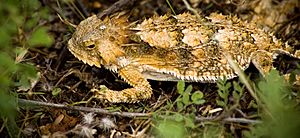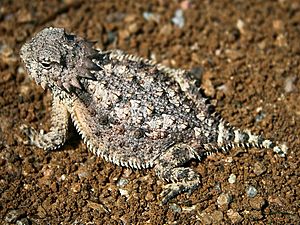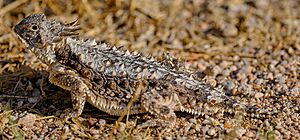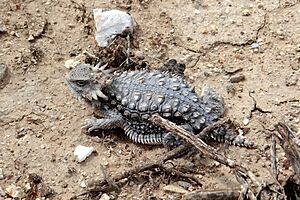Regal horned lizard facts for kids
Quick facts for kids Regal horned lizard |
|
|---|---|
 |
|
| Conservation status | |
| Scientific classification | |
| Genus: |
Phrynosoma
|
| Species: |
solare
|
The regal horned lizard (Phrynosoma solare) is a special type of horned lizard. You can find it in Mexico and the Southwestern United States. When seriously threatened or captured, they may exhibit a behavior that looks like something out of a science fiction movie: they squirt blood from their eyes!
Contents
Description
The regal horned lizard is a small, flat lizard. It's about the size of a grown-up's hand. Even though it has spikes all over its body, its main defense is quite surprising! It can squirt blood from its eyes.
Here are some cool facts about them:
- Their skin color is a brilliant example of natural camouflage. It ranges from pale gray to yellow-brown or reddish. They often have dark spots on their back and sides. These colors and patterns mimic the rocks, sand, and dry vegetation of its desert home, making it incredibly difficult to spot.
- They have four legs, and each leg has four toes with claws. These claws are essential for digging and gripping the sandy or rocky terrain.
- They are slow runners. Instead of running away, they use their amazing camouflage to hide from predators. When threatened, its first instinct is often to freeze and blend in, becoming virtually invisible to a predator's eye.
Size and weight
The regal horned lizard measures about 3 to 4 inches (approximately 117 millimeters) in length from its nose to the tip of its tail. This means it's roughly the size of the palm of a human's hand! It weighs only a few ounces.
Where They Live (Distribution)
These lizards are native residents of specific, sun-drenched regions. Their natural range stretches across parts of Mexico and the Southwest United States.
Geographic Hotspots:
- Southeastern Arizona: This is a primary location where these lizards thrive.
- Central Mountains Region (Southern Zone)
While they prefer the Sonoran Desert Mountains, their presence extends to other states like Texas, southern California, and New Mexico.
Their Home (Habitat)
This horned lizard likes flat or gently sloped areas. These places have open desert plants like mesquite trees, creosote bushes, and tall saguaro cacti. They love hot and dry weather. Sometimes, the ground where they live is covered in limestone dust.
What They Eat (Diet)
Regal horned lizards mostly eat harvester ants. They can eat a huge amount, like twenty-five hundred ants in just one meal! They eat slowly because they spend a lot of time in the desert's intense heat. They also enjoy eating flies, spiders, and other kinds of insects.
Behavior
These lizards are active all year long. However, they are most active during the warmer months, specifically from April to September. During this period, they are typically seen between 6:00 and 9:00 a.m., taking advantage of the cooler morning temperatures before the desert heat becomes too intense.
In winter, they usually only come out on warm days. They might even hibernate, or go into a deep sleep, from late September through October.
To stay safe from cold, regal horned lizards dig holes in the ground. They are skilled diggers. These holes are not just a shelter from the scorching sun and cold nights, but a safe place to build their nests.
Unique Basking Technique
One of their most intriguing behaviors is how they bask in the sun. A regal horned lizard will often bury itself in the sand, leaving only its head poking out. This isn't just for fun; it's a clever way to heat its blood. Inside its head, the lizard has a special chamber. When its head is exposed to the sun, the blood in this chamber warms up. Once the blood reaches a comfortable temperature, the lizard opens a special valve in its neck, allowing the warm blood to circulate throughout its entire body, effectively warming itself up without exposing its whole body to potential predators or overheating too quickly.
Astonishing Defense Mechanisms
While their spikes and camouflage are excellent first lines of defense, the regal horned lizard has a truly spectacular trick up its sleeve when seriously threatened or captured.
When facing a predator, they can squirt blood from their eyes! This isn't just a trickle; it's a stream that can reach up to 4 feet (1.2 meters) away and can be repeated several times.The blood comes out through tiny holes in their lower eyelids.
The blood is aimed directly at the predator's mouth and eyes. It's believed that this blood may have a foul taste that deters predators, or the sudden, unexpected stream of blood might simply startle and confuse them, giving the lizard a chance to escape.
Other ways they defend themselves include gulping air (to make themselves appear larger and more difficult to swallow) and poking with their horns.
Reproduction and Life Cycle
Regal horned lizards are oviparous, which means the females lay eggs rather than giving birth to live young.
Regal horned lizards start mating in late April. Mating is most common in June and stops in July. Egg laying begins a few weeks later, usually in late July and early August. A female lizard lays about 10 to 30 eggs, with 15 being the average.
The eggs are laid in carefully constructed nests. These nests are semicircular tunnels that the female digs at an angle. The angled tunnel design is crucial because it allows the nest to be shaded for longer periods of the day, protecting the developing eggs from the intense desert sun. They typically choose to nest in moist, fine silt or sand, which provides the ideal conditions for egg development. The eggshells are white and flexible. They are about half an inch across.
When baby lizards hatch, they get no help from their parents. They immediately bury themselves in the sand. From then on, they are on their own to find and hunt for food. To attract a mate, male lizards do special moves. These include bobbing their heads, doing "push-ups," and nodding.
Adaptations
The regal horned lizard is a living testament to the power of adaptation. From its spiky armor and camouflaged skin to its unique thermoregulation, specialized diet, and astonishing blood-squirting defense, every aspect of its biology and behavior is perfectly tuned to life in the desert. It's a true survivor perfectly designed for its environment.
See also
 In Spanish: Lagarto cornudo real para niños
In Spanish: Lagarto cornudo real para niños






